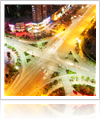
The center of an intersection is one of the most common accident spots. Four way stops with left and right hand turns have a lot going on, and if you are not an alert driver, you may be at serious risk to a car accident. The constant activity in an intersection is regulated by traffic lights or stop signs. Drivers are expected to follow these signals, or collisions are imminent. When a light is red, regardless of whether or not the intersection is open, it is very important that you wait. When a yellow light blinks on, then drivers should use this warning signal to slow down- not to speed up and try to beat the red light. Even when the light is green, exercise caution at intersections. Sometimes while you may be following the traffic laws, others may not be.
Intersections are a common accident sight partially because of "black spots." These are places where the driver's view is blocked by other cars or landscaping. A frequent example is when a large semi-truck pulls up to an intersection beside a compact car. The driver of the compact car will not be able to see around the large truck, so he or she will not know what to anticipate when pulling into the intersection. In situations like this, it is important to use extreme caution. Don't edge into an intersection without making many glances both ways.
When you are pulling into an intersection, there are some simple tips to remember. First of all, remember to traffic check. Like looking both ways before crossing the street, you should also take a quick survey directly prior to crossing an intersection in your vehicle. Sometimes an irresponsible driver may run a red light or a stop sign and be zooming through the intersection at lethal speed. A quick check to both sides will help to assure you that you are safe. Also, when pulling into an intersection, watch for "yield" left turn vehicles. Sometimes these drivers will be caught in an intersection waiting for a break in traffic. When that break does not come, they must make their turn on a yellow or even sometimes red, light to get out of the intersection. If you are not paying attention, you may speed forward when your traffic signal turns green and run into this person.
A word about left yield turns: these are one of the trickiest intersection maneuvers. A left hand yield involves pulling into an intersection on a green light and waiting for a break in traffic, then crossing that traffic in an attempt to make it to the other lane. When making a left hand turn, one must be very careful. If you must wait until the light turns yellow to move, make sure that there are not speedy drivers who could possibly move into the intersection. Make sure to get out of the intersection quickly, before other cars begin to move in.
If you are trying to make a right turn at an intersection, you may be able to move even when the light is red. You must come to a full stop, and then look both ways very intently before proceeding. In some cases, traffic will be so heavy that you will have to wait for your light to turn green before you can move. In other cases, the light may be red but there is no opposing traffic. If you cannot see the oncoming traffic, try to let your car coast a little further towards the intersection but never turn on a red light if your view is obstructed. Also, while you will be most focused on the vehicles coming towards you, make sure to make note of any passengers waiting to cross the street. If you only look left to watch for cars and fail to make note of the people on the sidewalk, you may hit them as they are crossing. In the end, make sure to stay alert and aware while driving, especially when approaching an intersection.